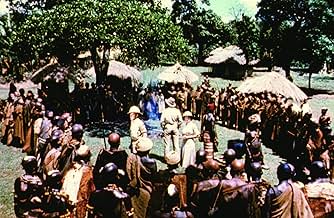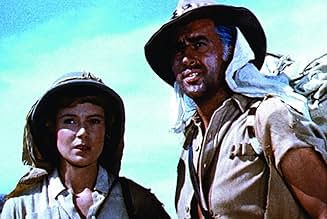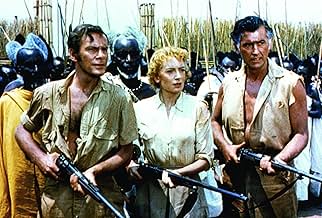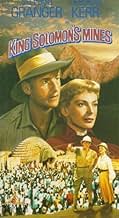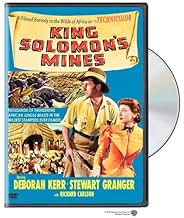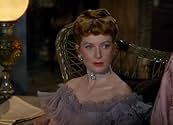O aventureiro Allan Quartermain lidera uma expedição em território africano desconhecido na tentativa de localizar um explorador que desapareceu.O aventureiro Allan Quartermain lidera uma expedição em território africano desconhecido na tentativa de localizar um explorador que desapareceu.O aventureiro Allan Quartermain lidera uma expedição em território africano desconhecido na tentativa de localizar um explorador que desapareceu.
- Direção
- Roteiristas
- Artistas
- Ganhou 2 Oscars
- 4 vitórias e 2 indicações no total
- Chief Gagool
- (as Sekaryongo of the Watussi Tribe)
- King Twala
- (as Baziga of the Watussi Tribe)
- Chief Bilu
- (não creditado)
- Austin - Safari Client
- (não creditado)
- Black Circle
- (não creditado)
- Kafa - Umbopa's Old Uncle
- (não creditado)
- Traum - Safari Client
- (não creditado)
- Direção
- Roteiristas
- Elenco e equipe completos
- Produção, bilheteria e muito mais no IMDbPro
Avaliações em destaque
Let me mention just one striking 'detail': what's going on on screen is SO fascinating that no music has been added to the various sounds emanating from the country or from the music instruments of the African people themselves. This was a daring move, especially at the time, but it enriched the movie enormously.
I will end this quick review with a piece of advice: Your mind should be as free as possible from everyday's life various troubles if you want to enjoy this movie. Pick up a night when you are already rather relaxed, and immerse yourself gently into the atmosphere created by the filmmakers. You won't regret it.
The filming started in Africa 1949, running time five months. The crew travelled by hundred miles in planes and trucks across Kenia, Uganda, Congo Belgian, Lagoon Victory, Falls of Murchisin and north of lagoon Tanganika where live the Watusi. Polished and coloristic production design by the veteran Cedric Gibbons. Heat and ills affected the crew and main actors but Deborah Kerr surprised for her resistance. There had confronting between Stewart Granger and Compton Bennett and Andrew Marton directed the second unity. Then, Metro Goldwyn Mayer dismissed Compton and Marton finished the picture. It was nominated for best movie and won Academy Award for cinematography by Robert Surtees and edition. Had several take-out with no use and later Metro Goldwyn Mayer utilized for its follow-up.
The picture is followed by a sequel, rapidly made, created with excess footage previous, titled 'Watusi'(1959) by Kurt Neumann with George Montgomery and David Farrar. An inferior version directed by J.Lee Thompson(1985) with Richard Chamberlain and Sharon Stone; and a TV adaptation directed by Steven Boyum with Patrick Swayze and Alison Doody, among others.
The film is very exciting. And you feel for the characters when they come into contact with danger. I wish more action films could make you do that. The performances are the reason behind this. It's too bad that the actors and actresses in the film weren't nominated for Oscars. I doubt they deserved to win, but they deserved to be up.
The script is also very good. It strays away from the book just a little bit. But I have no problem with that because the film, by itself, is very good.
The cinematography and editing are flawless. And they rightly won Oscars. The film was also nominated for Best Picture. It's one of the better adventure films.
Kerr is actually seeking the best of guides so she can hunt for her husband, so she takes along her good friend RICHARD CARLSON. Naturally, a romantic attachment to Granger gradually develops once Kerr starts to melt under the African sun.
All of the scenes involving actual native tribes are beautifully staged and handled with a sense of excitement and adventure, as are the scenes of wild animals. But it's basically a showcase for MGM's new property, Miss Kerr, and their new leading man, Mr. Granger.
It kept fans happy when it opened at New York's Radio City Music Hall in the summer of '50, but today it's largely forgotten among the many gems that came out that year. It did win a couple of Oscars, one for the beautiful color cinematography.
Você sabia?
- CuriosidadesThe elephant stampede sequence in the film was reshot in Hollywood using a trained elephant, as the footage of the actual stampede in Africa was lost when the cast and crew of the film fled from the deadly rush of the animals.
- Erros de gravaçãoThe elephant that charges the hunter and guide is an African elephant. The one that picks the guide up and tosses him over its shoulder is a trained Indian elephant. African elephants are too aggressive to be trained for such stunts.
- Citações
Allan Quatermain: Mrs. Curtis, the average life of a man in my profession is approximately eight years. Now, I've been at it for fifteen, so you see, I've been living on borrowed time. My wife died here six years ago. Sooner or later, an animal, or an unfriendly native, or a tropical disease will get me. I have a son in England. There'll be very little money for him if anything should happen to me in the ORDINARY course of events, but the money you're offering would provide very nicely for the boy until he's old enough to take care of himself.
- ConexõesEdited into Watusi - O Gigante Africano (1959)
Principais escolhas
Detalhes
- Data de lançamento
- País de origem
- Idioma
- Também conhecido como
- Las minas del rey Salomón
- Locações de filme
- Empresa de produção
- Consulte mais créditos da empresa na IMDbPro
Bilheteria
- Orçamento
- US$ 2.258.000 (estimativa)
- Faturamento bruto mundial
- US$ 951
- Tempo de duração1 hora 43 minutos
- Cor
- Proporção
- 1.37 : 1


